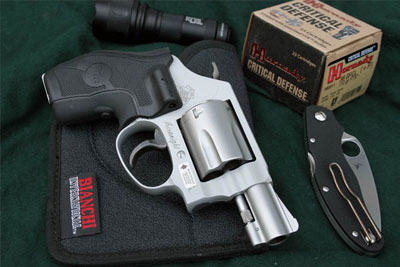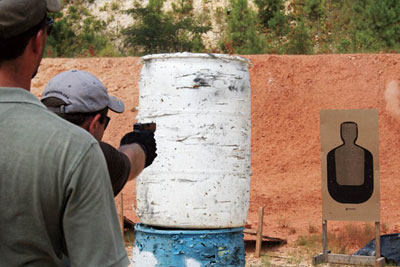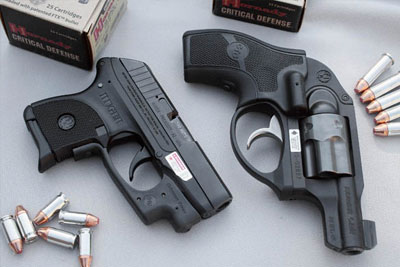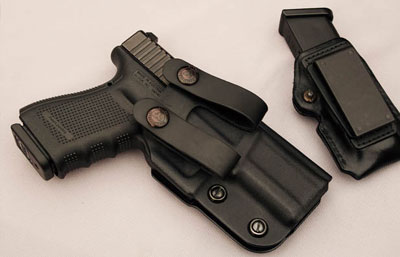
It's been said all the best stories begin with either "Once upon a time" or "There I was." There are other tales that begin with "I was talking to my buddy and he said…" Over the years, I've developed a reflexive cringe from all the times I've heard someone begin a conversation with such verbiage.
If we are talking about venison recipes or the best way to get red wine stains out of your dress shirt, opinions vary and it's not that big a deal if the advice doesn't quite pan out. However, when we are talking about the most important activity you can undertake—protecting your life and the lives of your family members—bad advice can have dire consequences.
In the United States today, there is little doubt concealed carry is one of the hottest topics, at least for gun owners. Sales figures for compact, concealable handguns bear out this argument. Furthermore, at last count, there was a grand total of one state that had absolutely no provision to allow their citizens to carry a concealed handgun. In the other states, the majority have shall-issue laws on the books.
Obtaining a lawful permit or permission to carry a concealed handgun is only one part of the equation. I've encountered dozens of citizens who obtained a permit but don't carry because they do not feel comfortable or capable of actually using a gun for personal protection. The reasons vary, but they generally boil down to a lack of training and/or misunderstanding what it means to be an armed citizen.
Carry Only When Needed
I am certain my face shows distress when I hear someone say they have a CCW permit but they "…only carry it when I think I might need it." My patent answer to that statement is, "If you think you are going to need a gun, don't go there." Or more aptly, "If you know you need a gun you should take a rifle or a shotgun, not a concealed handgun."
If I knew I was going to a fight I'd prefer to take the USS Missouri, but battleships are tough to conceal.
Carrying only once in a while, when you think you might need it, is akin to purchasing car insurance that only covers you on Friday nights from 6 p.m. to 2 a.m. and every other Saturday. Certainly, you wouldn't buy an insurance policy that only covered you on random dates or occasions.
When you obtain a carry permit, you are essentially purchasing life assurance—life insurance only kicks in once you are at room temperature. When you've decided to arm yourself against unknown, unanticipated threats, you need to do it as often as humanly possible.
Empty Chambers are Happy Chambers
In an effort to seem reasonable or extra safe, some permit holders will carry their semi-automatic pistols with a loaded magazine in place and the chamber empty. Not on the nightstand mind you, but in their holsters. I've also encountered double-action revolver owners who will deliberately prestage an empty chamber so the first hammer strike falls on nothing.
The reason for this thinking is typically little or no training and a bit of insecurity. In an effort to be "extra safe" by keeping the chamber empty, the gun owner is assuming they will always have the time and ability to draw their pistol and charge a round before they need to fire.
In both the semi-automatic and revolver scenarios, the shooter is purposely reducing his round count and increasing the amount of time it will take to get the gun in the fight. Should you be attacked with deadly force, time is likely not something you will have on your side and you may need every round you have.
One of the most dangerous aspects of this practice is you wind up playing the "Is my gun loaded or not?" game. It also leads to "It's alright, the chamber is empty," type of thinking. Loaded guns are safe guns because people treat them with respect. I once had a pistol fired into the ground 2 feet from me because the shooter thought the chamber was empty, so it would be safe to dry-fire.
Women Should Only Shoot .22s
While .22 LR handguns are fantastic training tools and excellent ways to learn the basics of marksmanship, they are not the best fight stoppers in the world. It is true, as my friend Walt Rauch once advised, "No one wants to leak, not even bad guys." However, there is no reason a healthy adult woman cannot carry and employ a centerfire handgun.
Not long ago, a woman told me when the subject of a defensive handgun came up, one of her male co-workers told her to buy a .22 and load it with dum-dum rounds. Yes, that was the exact term he used. Dum-dum rounds aside, the purpose of defensive shooting is to force the attacker to stop, not to bleed to death 20 minutes later.
A centerfire pistol or revolver with a bore diameter of .35 inch and up is a good place to start. Concealable handguns from .380 ACP up to .45 ACP abound and are readily available. The recoil impulse from the .45 ACP is generally less severe than that of a .40 S&W from the same-size handgun. I've encountered numerous women who could run a 1911 like no one's business. The question was not the sex of the shooter or their size, but rather their level of training and their experience.
Practice Gun Zen
Another common trend I've come across is the carry gun versus the range gun. Folks will go out and purchase the latest, greatest compact or subcompact pistol. They'll boast to their buddies about how easy it is to carry and conceal. They can carry it all day and forget it's in their pocket. That covers step one—be armed.
When it comes time to hit the range, these very same guys pull out a pistol with a 5- or 6-inch barrel, target sights and meticulously tuned trigger. From 10 yards, they set about punching neat little holes in paper targets and call it training.
Don't get me wrong, shooting should be enjoyable recreation. It can be a great way to spend an afternoon. However, if you bought a compact .380 ACP pistol for personal protection and still haven't gotten through your first box of 50 rounds, you are kidding yourself if you think you're ready for combat.
By their very design, compact, lightweight pistols and revolvers are easy to carry and difficult to shoot well. These guns demand you train and practice with them. You might be able to plink a soda can a 20 yards with a Ruger Mark III pistol, but that's not likely to be the gun you'll have on you when a bad guy shows up. Can you hit a soda can at 10 feet with your pocket pistol?
This is an easy trap to fall into. Your shot groups don't look as good with the pocket gun as they do with your larger target pistol. Park your ego at the door and practice with the pocket pistol. One day, you might be glad you did.
Hand Me Down That Gun
Many who decide to carry a gun are not gun people. They don't subscribe to any gun magazines and don't know or care about the history or nomenclature of firearms. All they know is they need a gun for personal protection. I've run into this many times during concealed-carry training courses and I've spoken to several trainers across the nation who agree this seems to be a trend.
Students, many of whom are women, will arrive at the class with gun handed down to them by great uncle Joe or grandpa Jim. Some have never put a single shot through the gun, but they load them up with the ammo uncle Joe gave them and keep them on the nightstand, the car or in their purses.
Far too many of these family heirlooms are in such poor condition, they can't be relied upon to fire two rounds in succession. During one course, I had a lady show up with a double-action revolver given to her by her grandfather. The timing was so out of whack, it took her three to four trigger pulls to get a cartridge to fire.
At another course, a shooter arrived with a compact .22 LR semi-automatic pistol passed down by a relative. This person had it for two years and had never fired a round through the gun. When it came time for the live-fire portion, we discovered it was essentially a single-shot pistol. The gun this citizen had been keeping loaded, "just in case," malfunctioned after the first shot and would not cycle or feed from the magazine.
The Winning Formula
The good news is when these folks show up for a training class, it becomes immediately, if not painfully, obvious they have been getting by on luck for a long time. Unfortunately, too many people feel owning a gun takes care of the personal-protection issue. To paraphrase Col. Jeff Cooper, owning a gun doesn't make you any more an armed citizen than owning a guitar makes you a musician.
It really is not possible to train yourself. You can practice on your own, but unless you've had professional instruction you are likely just ingraining bad habits. A good training course will teach you what to practice and the best ways to do so.
Shooters will often leave a course amazed at how much they didn't know when they arrived, and that is a positive thing. They are now on their way—they've become a student of the gun.
If you are truly serious about defending yourself with a firearm and carrying one on a regular basis, there are several steps you should take. Apply for your CCW permit, purchase a quality firearm, get some training and then practice often.
It's really not all that complex of a formula, but I'm dismayed by how many folks stop after the first step. When all is said and done, it's your life on the line—the choice is up to you.








































